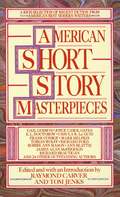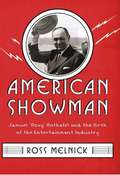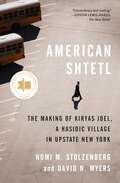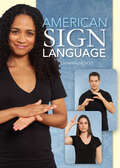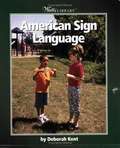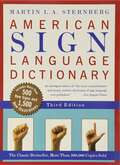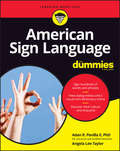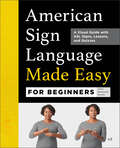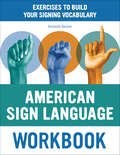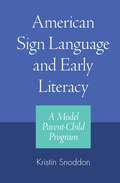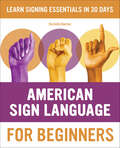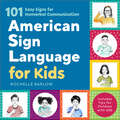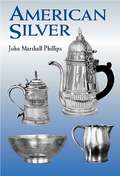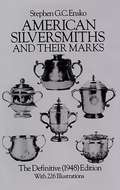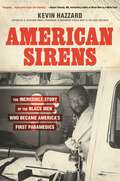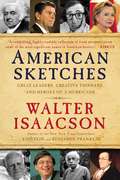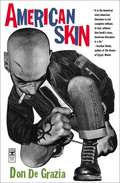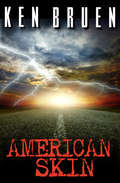- Table View
- List View
American Short Stories (Second Edition)
by Perfection Learning Editorial StaffThis collection of short stories introduces you to some of America's most important writers though you may not like every one, but each author has a unique message to send and a distinctive way of sending it.
American Short Stories: 1920 To Present
by Perfection LearningAn American father in search of his daughter in France. A ranch woman in the Salinas Valley who yearns for companionship and a sense of self-worth. A postmistress in Mississippi who decides to live at the post office after feuding with her eccentric family. A terrified soldier in Vietnam who longs for his Minnesota home. These are some of the characters and situations you will encounter in American Short Stories: 1920 to the Present. They are as varied as the geography of the U.S. itself.
American Short Story Masterpieces
by Raymond Carver Tom JenksThis highly acclaimed collection of short stories by American writers contains only the best literary art of the past four decades. With a bias toward realism, editors Raymond Carver and Tom Jenks have selected fiction that "tells a story" and tells it with a masterful handling of language, situation, and insight. But what is so special about this volume is that it mirrors our age, our concerns, and our lives. Whether it's the end of a marriage, as in Bobbie Ann Manson's "Shiloh," or the struggle with self-esteem and weight in Andre Dubus's "The Fat Girl," the 36 works included her probe issues that give us that "shock of recognition" that is the hallmark of great art--wonderful, absorbing fiction that will be read and reread for decades to come.
American Showman: Samuel "Roxy" Rothafel and the Birth of the Entertainment Industry, 1908–1935 (Film and Culture Series)
by Ross MelnickSamuel "Roxy" Rothafel (1882–1936) built an influential and prolific career as film exhibitor, stage producer, radio broadcaster, musical arranger, theater manager, war propagandist, and international celebrity. He helped engineer the integration of film, music, and live performance in silent film exhibition; scored early Fox Movietone films such as Sunrise (1927); pioneered the convergence of film, broadcasting, and music publishing and recording in the 1920s; and helped movies and moviegoing become the dominant form of mass entertainment between the world wars. <P><P>The first book devoted to Rothafel's multifaceted career, American Showman examines his role as the key purveyor of a new film exhibition aesthetic that appropriated legitimate theater, opera, ballet, and classical music to attract multi-class audiences. Roxy scored motion pictures, produced enormous stage shows, managed many of New York's most important movie houses, directed and/or edited propaganda films for the American war effort, produced short and feature-length films, exhibited foreign, documentary, independent, and avant-garde motion pictures, and expanded the conception of mainstream, commercial cinema. He was also one of the chief creators of the radio variety program, pioneering radio broadcasting, promotions, and tours.The producers and promoters of distinct themes and styles, showmen like Roxy profoundly remade the moviegoing experience, turning the deluxe motion picture theater into a venue for exhibiting and producing live and recorded entertainment. Roxy's interest in media convergence also reflects a larger moment in which the entertainment industry began to create brands and franchises, exploit them through content release "events," and give rise to feature films, soundtracks, broadcasts, live performances, and related consumer products. Regularly cited as one of the twelve most important figures in the film and radio industries, Roxy was instrumental to the development of film exhibition and commercial broadcasting, musical accompaniment, and a new, convergent entertainment industry.
American Shtetl: The Making of Kiryas Joel, a Hasidic Village in Upstate New York
by David N. Myers Nomi M. StolzenbergA compelling account of how a group of Hasidic Jews established its own local government on American soilSettled in the mid-1970s by a small contingent of Hasidic families, Kiryas Joel is an American town with few parallels in Jewish history—but many precedents among religious communities in the United States. This book tells the story of how this group of pious, Yiddish-speaking Jews has grown to become a thriving insular enclave and a powerful local government in upstate New York. While rejecting the norms of mainstream American society, Kiryas Joel has been stunningly successful in creating a world apart by using the very instruments of secular political and legal power that it disavows.Nomi Stolzenberg and David Myers paint a richly textured portrait of daily life in Kiryas Joel, exploring the community's guiding religious, social, and economic norms. They delve into the roots of Satmar Hasidism and its charismatic founder, Rebbe Joel Teitelbaum, following his journey from nineteenth-century Hungary to post–World War II Brooklyn, where he dreamed of founding an ideal Jewish town modeled on the shtetls of eastern Europe. Stolzenberg and Myers chart the rise of Kiryas Joel as an official municipality with its own elected local government. They show how constant legal and political battles defined and even bolstered the community, whose very success has coincided with the rise of political conservatism and multiculturalism in American society over the past forty years.Timely and accessible, American Shtetl unravels the strands of cultural and legal conflict that gave rise to one of the most vibrant religious communities in America, and reveals a way of life shaped by both self-segregation and unwitting assimilation.
American Sideshow: An Encyclopedia Of History's Most Wondrous And Curiously Strange Performers
by Marc HartzmanA fascinating look into the history of the American sideshow and its performers. Learn what's real, what's fake, and what's just downright bizarre. You've probably heard of Tom Thumb. The Elephant Man. Perhaps even Chang and Eng, the original Siamese twins. But what about Eli Bowen, the legless acrobat? Or Prince Randian, the human torso? These were just a few of the many stars that shone during the heyday of the American sideshow, from 1840 to 1950. American Sideshowchronicles the lives of truly amazing performers, examining these brave and extraordinary curiosities not just as sideshow performers but as people, delving into the lives they led and the ways they were able to triumph over and even benefit from their abnormalities. American Sideshowdiscusses the rise and fall of the original sideshows and their subsequent replacement by today's self-made freaks. With the progress of modern medicine, technological advancements, and the wonderful world of body modification, abnormalities are being overcome, treated and even prevented: Siamese twins can now be separated, and in addition to this, tongues can be forked, horns surgically implanted, and earlobes removed. There are also, of course, modern-day giants, fire eaters, sword swallowers, glass eaters, human blockheads, and oh, so much more. These fascinating personalities are celebrated through intimate biographies paired with stunning photographs. Approximately two hundred performers from the past one hundred and sixty years are featured, giving readers a comprehensive and sometimes astonishing look into the history of the American sideshow
American Sign Language
by Catherine NicholsIt's the third most used language in the United States-and yet it's "spoken" without even opening your mouth! It's estimated that as many as two million Americans speak American Sign Language, a method of communication that's both fun and useful, even if you or your friends and family are not hearing impaired.American Sign Language uses simple-to-follow photographs to teach you the alphabet, numbers, and simple words and phrases. Divided into categories such as Animals and People and Pronouns, the book and accompanying flashcards show you how to use your hands to communicate. Once you've learned the alphabet, you'll build on that knowledge to learn the words for "friend" and "family." And when you how the words for "chicken" and "cat" evoke a chicken opening and closing its beak and a cat stroking its whiskers, you'll truly understand how intuitive and enjoyable learning American Sign Language can be.Learning a new language is always a rewarding endeavor-and with American Sign Language, it's easier than ever!
American Sign Language
by Deborah KentThis book gives young readers a brief overview of American Sign Language (ASL). The book focuses on the history of ASL and the controversies which have surrounded it since its inception.
American Sign Language Dictionary
by Martin L. SternbergDeaf since the age of seven, Martin L. A. Sternberg, Ed.D., spent most of his career working with deaf people. Inspired by his sign language teacher at Gallaudet University in Washington, DC, he devised this vital reference to help anyone learn to speak with their hands. <p><p>A must for parents, instructors, and students, American Sign Language Dictionary includes everything you need to know to communicate clearly using ASL. This illustrated abridgment of the most authoritative reference book on sign language features more than 5,000 signs and 8,000 illustrations, as well as clear, detailed instructions to help you master each sign.
American Sign Language Dictionary for Beginners: A Visual Guide with 800+ ASL Signs
by Tara AdamsA user-friendly dictionary with 800+ ASL signs Whatever your reason for learning the richly expressive language of American Sign Language (ASL), this book will guide you through the initial stages of your signing journey. It's filled with everything you need to master more than 800 essential vocabulary words, including detailed directions that make it simple to develop your ASL skills.What sets this dictionary apart from other sign language books for beginners:No experience required—Find comprehensive, clearly written guidance that makes sense of American Sign Language for beginners, with helpful explanations of more difficult concepts, plus plenty of tips for success.Instructional photographs—See ASL in action with full-color photographs that illustrate how to sign each vocabulary word.Easy-to-find signs—Study each sign in alphabetical order or search by category with a handy index that organizes signs by activities, animals, emotions, places, events, and more.Build up your ASL vocabulary with the American Sign Language Dictionary for Beginners.
American Sign Language For Dummies
by Angela Lee Taylor Adan R. Penilla IIGrasp the rich culture and language of the Deaf community To see people use American Sign Language (ASL) to share ideas is remarkable and fascinating to watch. Now, you have a chance to enter the wonderful world of sign language. American Sign Language For Dummies offers you an easy-to-access introduction so you can get your hands wet with ASL, whether you're new to the language or looking for a great refresher. Used predominantly in the United States, ASL provides the Deaf community with the ability to acquire and develop language and communication skills by utilizing facial expressions and body movements to convey and process linguistic information. With American Sign Language For Dummies, the complex visual-spatial and linguistic principles that form the basis for ASL are broken down, making this a great resource for friends, colleagues, students, education personnel, and parents of Deaf children. Grasp the various ways ASL is communicated Get up to speed on the latest technological advancements assisting the Deaf Understand how cultural background and regionalism can affect communication Practice signing with videos online If you want to get acquainted with Deaf culture and understand what it's like to be part of a special community with a unique shared and celebrated history and language, American Sign Language For Dummies gets you up to speed on ASL fast.
American Sign Language Made Easy for Beginners: A Visual Guide with ASL Signs, Lessons, and Quizzes
by Travis Belmontes-MerrellLearn American Sign Language the easy way! Become a lifelong learner of American Sign Language (ASL) with this guide for true beginners. It breaks down ASL fundamentals and gives you step-by-step instructions for signing more than 400 vocabulary words, organized by practical topics like greetings, hobbies, times, places, and more.The building blocks of ASL—Lay the foundation for ASL learning as you explore the five parameters of signing: handshape, location, movement, palm orientation, and non-manual markers.Clear guidance for novices—Learn how to sign each vocabulary word with the help of detailed written directions and large, full-color photos, so you know you're doing it right even if it's your first sign ever.Lessons and quizzes—Put your new skills to the test with themed lessons designed for real-world conversations, and brief quizzes at the end of each section.Make learning ASL fun and easy with this top choice in American Sign Language books for beginners.
American Sign Language Workbook: Exercises to Build Your Signing Vocabulary
by Rochelle BarlowThe simple way to start learning American Sign LanguageThis foundational workbook makes it easy to get started with American Sign Language. Focusing on practical vocabulary and basic grammar, this workbook is ideal for anyone trying to understand and speak ASL right away. Across 30+ lessons, you'll be introduced to the essentials, including everyday vocabulary, introductory phrases, and conversational basics.Everyday communication—Lessons are centered around real-world situations, including greetings, emotions, family, work, travel, and health.Easy-to-understand lessons—High-quality photos support the straightforward sign descriptions and ensure accurate instruction.Practice makes perfect—Test your knowledge with a variety of exercises, including matching, fill-in-the-blanks, and more.Lay the foundation for strong signing skills with the simple exercises in this sign language workbook.
American Sign Language and Early Literacy: A Model Parent-Child Program
by Kristin SnoddonThe usual definition of the term "literacy" generally corresponds with mastering the reading and writing of a spoken language. This narrow scope often engenders unsubstantiated claims that print literacy alone leads to, among other so-called higher-order thinking skills, logical and rational thinking and the abstract use of language. Thus, the importance of literacy for deaf children in American Sign Language (ASL) is marginalized, asserts author Kristin Snoddon in her new book American Sign Language and Early Literacy: A Model Parent-Child Program. As a contrast, Snoddon describes conducting an ethnographic, action study of the ASL Parent-Child Mother Goose program, provided by a Deaf service agency in Ontario, Canada to teach ASL literacy to deaf children. According to current scholarship, literacy is achieved through primary discourse shared with parents and other intimates, which establishes a child's initial sense of identity, culture, and vernacular language. Secondary discourse derives from outside agents and interaction, such as expanding an individual's literacy to other languages. Snoddon writes that the focus of the ASL Parent-Child Mother Goose program is on teaching ASL through rhymes and stories and some facets of the culture of Deaf ASL users. This focus enabled hearing parents to impart first-language acquisition and socialization to their deaf children in a more natural primary discourse as if the parents were Deaf themselves. At the same time, hearing parents experience secondary discourses through their exposure to ASL and Deaf culture. Snoddon also comments on current infant hearing screening and early intervention and the gaps in these services. She discusses gatekeeper individuals and institutions that restrict access to ASL for young Deaf children and their families. Finally, she reports on public resources for supporting ASL literacy and the implications of her findings regarding the benefits of early ASL literacy programming for Deaf children and their families.
American Sign Language for Beginners: Learn Signing Essentials in 30 Days
by Rochelle BarlowA 30-day beginner's guide for learning American Sign LanguageThere's an easy way to leap right in to learning American Sign Language (ASL). American Sign Language for Beginners delivers 30 days of lessons that will help you sign with those in your home, community, and classroom.From letters and numbers to essential vocabulary and grammar basics, this beginner's guide provides the essentials needed to develop a solid foundation for American Sign Language in the real world. Each daily lesson takes less than 30 minutes to complete and focuses on a single set of vocabulary or ASL grammar. Throughout the course, you'll find key phrases, helpful memory tips, signing practice activities, and insight into deaf culture. Start your ASL masterclass today.American Sign Language for Beginners includes:30 Days of easy ASL—Start off right with an accelerated plan designed to help you begin signing in just one month.Easy-to-understand instructions—Lessons concentrate on a single idea or subject and include photographs to demonstrate signs.Everyday phrases—Daily instruction highlights vocabulary you're most likely to need as you explore ASL in your daily life.Jump-start your learning experience with American Sign Language for Beginners!
American Sign Language for Kids: 101 Easy Signs for Nonverbal Communication
by Rochelle BarlowThe easy way for kids ages 3 to 6 (and parents) to learn American Sign LanguageThere has never been a better way to start learning American Sign Language. Ideal for parents of nonverbal children or children with communication impairments in the preschool or kindergarten age range, American Sign Language for Kids offers a simple way to introduce both of you to ASL.Build your vocabularies with 101 signs perfect for everyday use, all featuring detailed illustrations, memory tips, and hands-on activities. American Sign Language for Kids helps you focus on the types of words you need most with chapters conveniently divided by category. Get chatty with activities that guide you through conversations. You'll be signing together in no time!American Sign Language for Kids includes:101 Helpful signs—From family and feelings to meals and playtime, work with your child to master subjects that will help the two of you connect.Fun ways to practice—Discover enjoyable activities at the end of each section that make it exciting and engaging to learn signs and start conversing!Practical guides—Get useful advice for introducing signs to a child with autism, helpful primers on deaf culture, and more.Discover an effective and meaningful way to deepen communication with your child—American Sign Language for Kids shows you the way.
American Silences: The Realism of James Agee, Walker Evans, and Edward Hopper
by Joseph Anthony WardIn ""American Silences"", Joseph Anthony Ward offers a unique analysis of the use and effects of silence in modern American realistic art. Beginning with the nineteenth-century literature that laid the foundation for silence in art, he moves to a brief analysis of Sherwood Anderson's ""Winesburg"", Ohio and Ernest Hemingway's ""In Our Time"", showing how they, along with several other crucial works of twentieth-century American realism, incorporate the power of the silent into their expression without sacrificing the subjects and techniques of traditional realism. Examining ""Let Us Now Praise Famous Men"", James Agee's commentary on the life of tenant farmers, documented with photographs by Walker Evans, Ward traces the book's pattern of 'silence, then silence disturbed by sound, and ultimately silence restored'. Ward further supports his theory with a study of Agee's ""A Death in the Family"" and Evans' ""American Photographs"". Ward sees Agee's admiration of photography as a connection between the silence of the scenes he writes about and the silence of Evans' photographs. The use of silence is perhaps even more obvious in the paintings of Edward Hopper. Although throughout the book Ward suggests both the positive and negative qualities of silence in art, Hopper's paintings provide little in the way of postiveness. For Ward, the art of silence is an art of extreme concentration that seeks essences rather than superficiality that nearly transcends realism itself. The theme of silence in American realism is a significant new one, but Ward's interpretation of the prose and his analysis of the photographs and paintings, many of which are reproduced in this book, establish validity for art as the voice of silence.
American Silver
by John Marshall PhillipsA practical guide to recognizing, identifying, and appreciating the finest American silverwork. Photographs and drawings of masterworks from leading collections show some of the finest work by Jacob Hurd, Jeremiah Dummer, Peter van Dyck, Edward Winslow, John Coney, Paul Revere, and other renowned silversmiths. 52 halftones, 14 black-and-white line illustrations.
American Silversmiths and Their Marks: The Definitive (1948) Edition
by Stephen G. Ensko"So thoroughly is the American ethos embodied in the works of American silversmiths that it has given to their product a typical identity and it never can be mistaken for that of any other country." -- Charles Messer Stow in the Introduction.Forsaking the flourishes and ornamentation favored by their European contemporaries, early American gold- and silver smiths pioneered a new American aesthetic sensibility in creating for their well-heeled clients finely worked, luxurious metalware for the table, which was marked by a simplicity and forthrightness of design. These accomplished artisans have left us not only a stunning legacy of priceless silverware but also an opportunity to examine the culture, lifestyle, and values -- in short, the developing ethos -- of young America. For social and cultural historians as well as Americana buffs, the study of silversmithing in this book will provide a unique perspective on a spirited new nation. For serious connoisseurs of American gold and silver ware, silver dealer Stephen G. C. Ensko's American Silversmiths and Their Marks is a rich and definitive directory. Ensko has compiled an exhaustive list of over 3,000 gold- and silversmiths working between the years 1650 and 1850. Biographical details and location of their shops are given wherever possible. Maps of the great metropolitan centers of smithing (Boston, New York, and Philadelphia) with shop locations noted are appended. Over 200 of the finest examples of the work of early American artisans are displayed in sharp, clear black-and-white photographs. Items include tankards, cups, candlesticks, sugar boxes, inkstands, tea sets, porringers, plus a pitcher, sauce dish, teapot, and other works by famous New England patriot Paul Revere. The usefulness of this work is perhaps most apparent in the practical listing of identifying marks associated with gold- and silversmiths. With over 3,000 entries, this feature alone renders American Silversmiths and Their Marks indispensable to enthusiasts interested in tracking down and identifying antique pieces.
American Sirens: The Incredible Story of the Black Men Who Became America's First Paramedics
by Kevin HazzardThe extraordinary story of an unjustly forgotten group of Black men in Pittsburgh who became the first paramedics in America, saving lives and changing the course of emergency medicine around the world Until the 1970s, if you suffered a medical crisis, your chances of survival were minimal. A 9-1-1 call might bring police or even the local funeral home. But that all changed with Freedom House EMS in Pittsburgh, a group of Black men who became America&’s first paramedics and set the gold standard for emergency medicine around the world, only to have their story and their legacy erased—until now.In American Sirens, acclaimed journalist and paramedic Kevin Hazzard tells the dramatic story of how a group of young, undereducated Black men forged a new frontier of healthcare. He follows a rich cast of characters that includes John Moon, an orphan who found his calling as a paramedic; Peter Safar, the Nobel Prize-nominated physician who invented CPR and realized his vision for a trained ambulance service; and Nancy Caroline, the idealistic young doctor who turned a scrappy team into an international leader. At every turn, Freedom House battled racism—from the community, the police, and the government. Their job was grueling, the rules made up as they went along, their mandate nearly impossible—and yet despite the long odds and fierce opposition, they succeeded spectacularly. Never-before revealed in full, this is a rich and troubling hidden history of the Black origins of America&’s paramedics, a special band of dedicated essential workers, who stand ready to serve day and night on the line between life and death for every one of us.
American Sketches: Great Leaders, Creative Thinkers, and Heroes of a Hurricane
by Walter IsaacsonWhat are the roots of creativity? What makes for great leadership? How do influential people end up rippling the surface of history? In this collection of essays, Walter Isaacson reflects on the lessons to be learned from Benjamin Franklin, Albert Einstein, Bill Gates, Henry Kissinger, Ronald Reagan and Mikhail Gorbachev, Hillary Clinton and Bill Clinton, and various other interesting characters he has chronicled as a biographer and journalist. The people he writes about have an awesome intelligence, in most cases, but that is not the secret of their success. They had qualities that were even more rare, such as imagination and true curiosity. Isaacson reflects on how he became a writer, the lessons he learned from various people he met, and the challenges he sees for journalism in the digital age. He also offers loving tributes to his hometown of New Orleans, which both before and after Hurricane Katrina offered many of the ingredients for a creative culture, and to the Louisiana novelist Walker Percy, who was an early mentor. In an anecdotal and personal way, Isaacson describes the joys of the "so-called writing life" and the way that tales about the lives of fascinating people can enlighten our own lives.
American Skin
by Don De GraziaThe story of Alex Verdi who joins a multi-racial group of anti-Nazi skinheads.
American Skin
by Ken BruenAt the beginning of Bruen's dark tribute to the Irish fascination with the American dream, Stephen Blake is on the run after a bank heist, hoping to disappear in the desert near Tucson. Blake has the money and his girlfriend, Siobhan, knows how to launder it. All he has to do is change his accent and his skin and pass as an American. But John A. Stapleton, contract killer for the IRA, wants more than his share of the swag--and the psychotic Dade, obsessively devoted to the music of Tammy Wynette, is wandering the Southwest like a slaughter wagon. Noir master Bruen (The Guards) effortlessly moves his storyline back and forth in time, all his trademark pop-culture references in place, the banshee of existential agony wailing loudly.
American Skin: A Novel
by Ken BruenAt the beginning of Bruen&’s dark tribute to the Irish fascination with the American dream, Stephen Blake is on the run after a bank heist, hoping to disappear in the desert near Tucson. Blake has the money and his girlfriend, Siobhan, knows how to launder it. All he has to do is change his accent and his skin and pass as an American. But John A. Stapleton, contract killer for the IRA, wants more than his share of the swag—and the psychotic Dade, obsessively devoted to the music of Tammy Wynette, is wandering the Southwest like a slaughter wagon. Noir master Bruen (The Guards) effortlessly moves his storyline back and forth in time, all his trademark pop-culture references in place, the banshee of existential agony wailing loudly.


